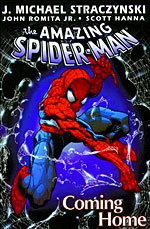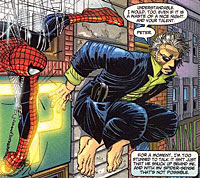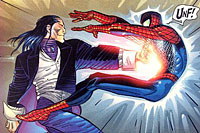>> The Book Review: The Horde
>> What About Bob? An interview with Bob Schreck, Part Two
More...

 Writer: J Michael Straczynski
Writer: J Michael Straczynski
Artist: John Romita Jr
Colourist: Dan Kemp, Avalon
Letterer: Comicraft
Inker: Scott Hanna
Collecting THE AMAZING SPIDER-MAN #30-35
Price: $15.95
Publisher: Marvel
ISBN: 0785108068
J Michael Straczynski was already a legend when he turned to writing comics. Creating, executive producing and writing almost every episode of sci fi show BABYLON 5 has assured him a lofty place when the definitive history of TV science fiction is written. It wasn't necessarily a logical step when he began developing creator-owned comics for Top Cow, then moved to Marvel to take over writing THE AMAZING SPIDER-MAN.
Before the movies, Spider-Man was an icon, but not the most interesting character at Marvel. Ever sine Gwen Stacy died, the character had faded to a fairly bland status quo, aside from occasional highlights like KRAVEN'S LAST HUNT or the Venom storylines. Brian Michael Bendis' writing on ULTIMATE SPIDER-MAN, which outshines most regularcomic books, made the regular Spidey titles look even duller by comparison.
Straczynski's solution was to create a new status quo, and inject the title with some new ideas. Part of what made Marvel so successful in the 60s was the interplay between being a superhero and having a life. The publisher thrived on questions of responsibility and the stresses that power could create. How a teenager deals with these issues and how an adult faces them are two very different things, so Straczynski began by having Peter Parker become a science teacher at his old high school, drawing a line between the adult and the youth.
 Parker also gains a new mentor, or at least a friend, in Ezekiel Sims, an old man with spider powers who knows almost everything about Spider-Man and Peter. Ezekiel offers Peter an alternate origin story; it wasn't the radiation that gave Peter powers, it was the spider. Rather than being a freak of the modern age, Peter is part of a line of totemic heroes that stretch back to the dawn of time, which is why so many of his villains have taken the forms of animals (Vulture, Octopus, Rhino, Lizard, Scorpion, Cat, etc.), subconsciously guided to embrace a totem and oppose him.
Parker also gains a new mentor, or at least a friend, in Ezekiel Sims, an old man with spider powers who knows almost everything about Spider-Man and Peter. Ezekiel offers Peter an alternate origin story; it wasn't the radiation that gave Peter powers, it was the spider. Rather than being a freak of the modern age, Peter is part of a line of totemic heroes that stretch back to the dawn of time, which is why so many of his villains have taken the forms of animals (Vulture, Octopus, Rhino, Lizard, Scorpion, Cat, etc.), subconsciously guided to embrace a totem and oppose him.
It's an interesting idea, and one that Straczynski has explored through much of his run, though this story arc leaves it on a somewhat ambiguous note because regardless of the spider totems Ezekiel talks about, Peter knows that his powers derive at least in part from science, something he proves in the story's finale, which lets Peter Parker the scientist take center stage.
The major villain is Morlun, a vampiric creature who feeds on people. Straczynski's run on the series has focused on supernatural elements and the constant mystical villains have worn the patience of some fans, but in this first story arc it worked brilliantly.
Besides offering an alternate origin, Ezekiel also questions Peter's motivation. Peter tells him that with great power comes great responsibility, to which Ezekial asks, "What comes with great responsibility? What's the other half of the equation? Power? Freedom? Guilt?"
Penciller John Romita Jr and inker Scott Hanna have become the definitive Spider-Man artists since Todd MacFarlane left Marvel. Romita's a brilliant superhero artist, and there are dozens if not hundreds of panels he's drawn that deserve to be blown up to poster size. They jump off the panel with kinetic energy and really capture what makes the character an icon. It's a damn shame that the makers of the movie didn't hire him to draw a poster for them, which could have been as iconic as the Hildebrandt STAR WARS and Drew STRUZAN INDIANA JONES posters.
 Romita isn't generally great at displaying complex emotions - there are some panels in which a character has a neutral expression that's supposed to suggest internal conflict, but it comes off flat - but there are panels where he's able to express a great deal with just a character's eyes or a smile. Of course, Romita's shortcomings pale in comparison to his skills, and there's only so much range of expression a character in a mask can have, so he's had to use body language to convey much of his hero's character, and at this he excels. In the scene where Peter is losing to Morlun and phones Mary Jane only to get her machine, the posture alone makes the emotion of the scene unmistakeable.
Romita isn't generally great at displaying complex emotions - there are some panels in which a character has a neutral expression that's supposed to suggest internal conflict, but it comes off flat - but there are panels where he's able to express a great deal with just a character's eyes or a smile. Of course, Romita's shortcomings pale in comparison to his skills, and there's only so much range of expression a character in a mask can have, so he's had to use body language to convey much of his hero's character, and at this he excels. In the scene where Peter is losing to Morlun and phones Mary Jane only to get her machine, the posture alone makes the emotion of the scene unmistakeable.
What makes the story so good are the elements that get to the core of Peter Parker and Spider-Man. His selflessness, his concern for others, his love for Aunt May and Mary Jane, his inner torment. It shows Peter the fighter and Peter the scientist. It also shows his rage.
When he's down for the count fighting Morlun, Peter thinks, "I always knew that sooner or later, I'd lose. It's math, you see. Statistics. No one wins forever. No one. Only thing that matters is how you face it when the cards don't come up your way. I'm not afraid. I'm tired, but I'm not afraid". At its heart, SPIDER-MAN is about a boy who was tormented by others, forced to keep his rage bottled inside, and when he had the opportunity, he used his rage to keep other people from suffering, and to stop those who would torment others. It's not easy and it's not always fun, but it's noble. It's what the best of us would do.
That's why most of the action in the movies took place when Peter wasn't in costume. That's why the character resonates with us. And it's how we like Peter Parker, struggling to juggle all his responsibilities and always this close to failing. It's why so many of his villains are tragic and sympathetic. It can get lost amid elaborate story arcs, fighting new villains every month, but Straczynski, Romita and Hanna know understand the character, and in COMING HOME they've managed to get it right.

This article is Ideological Freeware. The author grants permission for its reproduction and redistribution by private individuals on condition that the author and source of the article are clearly shown, no charge is made, and the whole article is reproduced intact, including this notice.


